Emily Hall Tremaine’s 1930s: In danger, madness, decadence and publicity
Art Design Publicity at ADC | Emily Hall Tremaine / Collection
| 2 August 2021 | Updated 10 September 2023
This micro-site and webpage are packed with a lot of new information clarifying Emily’s work and life.
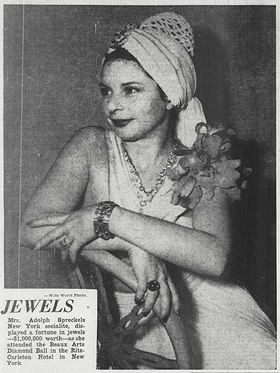
|
Left: Wire service photo of Emily Hall Tremaine (previously Spreckels) wearing in today’s value from USD$14.5-220m in diamonds, and stealing the press at the Beaux Arts Ball in New York, probably partly a piss-take and signalling her move up the society ladder (Pittsburgh Post-Gazette, 30 January 1940, p. 22.) Six months earlier, she was cash poor. Months later, her life and media coverage went horribly wrong, again. |
"Not one HINT of antisemitism," insisted Emily Hall Tremaine’s younger friend to me four years ago. "I did hear rumors, but nothing real."
This kept me digging, and led to the obvious: pull the court record around the shocking divorce case she was in, 1940-41. Inside, as if waiting to be discovered was Emily’s secret deposition, presumably put there by her in consultation with her lawyer. I may have indeed been the first person to see it.
For the first time since Emily died in 1987, Emily can finally "speak" for herself again regarding her life in the dangerous 1930s!
In the 1930s, Emily was a titled socialite / society-literary magazine editor in Santa Barbara, California with extensive contact in Los Angeles. Referred to as a "social leader" often in the Southern California and US national press, she was consistently mentioned socializing with celebrities, writers, producers and other socialites, and the media coverage also reported on Emily’s work for the start-up Apéritif magazine as an entrepreneurial female figure (1934-36). The magazine, her role, and social / personal life became content in news wires producing waves of nationwide publicity.
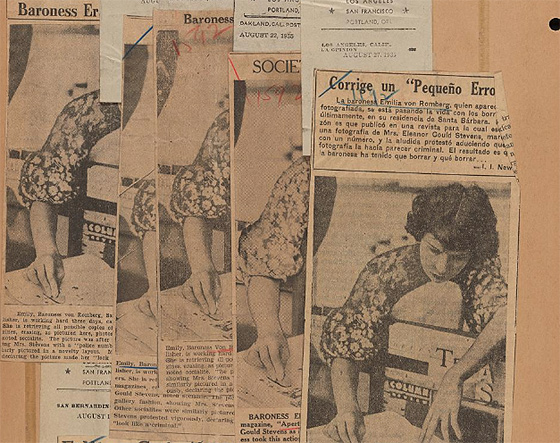
Cropped view of page in Emily Hall Tremaine’s 1930s scrapbook showing multiple media coverage on her and her work at Aperitif magazine. In August 1935, about the age of 27, Emily (von Romberg, previously) was threatened with a defamation claim; in response she staged—or agreed to— a photo-op, in which she scratched out the complaintant’s name and photo on remaining magazine copies. This was then reported by multiple media outlets. (Note the white slips; she appears to have hired a clipping agency to gather her press coverage.) Was Emily’s work a little-known predecessor to Andy’s Warhol’s interest in multiple media coverage? How familiar was Warhol with news photos and reports about Emily c. 1940 in the Pittsburgh newspapers— and others— via wire services? What did Warhol know about Emily when he met her— and knew her?
Her work included, for example, slating Rupert Hughes (Hollywood Anti-Nazi League) as a chairman for her magazine’s awards for California writers. (In late 1935, Emily was huddled with Rupert Hughes, and Hughes was huddled with Julius Klein, top Jewish U. S. military intelligence guy, against rabid Nazis in downtown Los Angeles.)
Later, Emily’s personal relationships took a shocking downturn and were widely reported in the US national press. This was via news wires with publication in the full range of newspapers in US cities and in smaller towns.
Plane suspiciously nosedives into a river
In 1938, she experienced the death of her first husband, Max von Romberg, a polo player / adventurist also often reported in the media, who died in a suspicious plane crash in New Jersey. Max was flying his plane to a polo match, and was also quietly securing American citizenship and expatriating from Germany, unknown to the public. Emily’s niece, Janie Noble (born c. 1940), in interview in 2006, recalls, "She’d start talking about him and start crying... She admitted to me once that Max was the true love of her life." [Degen Pener. "The original It Girl", Santa Barbara magazine (c. December 2006).] (See more about Emily and Max von Romberg.)
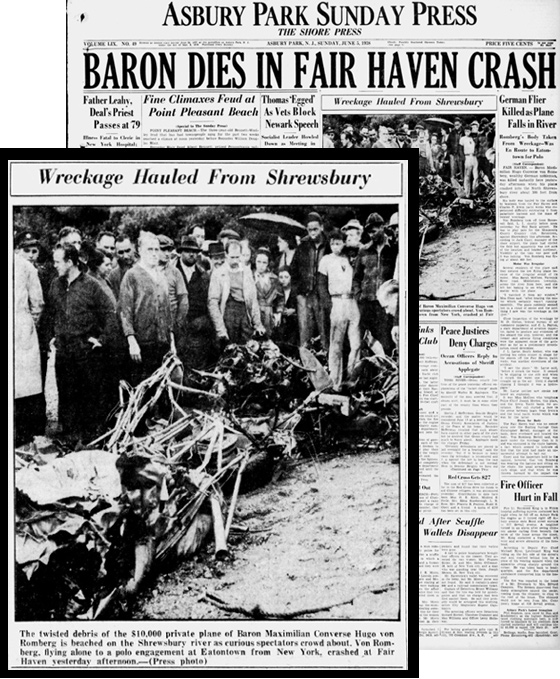
Front page of Asbury Park Sunday Press with press photo showing the wreckage of the plane crash causing the death of Max von Romberg in New Jersey in 1938. He was flying his plane to a polo match, and was also quietly securing American citizenship and expatriating from Germany, unknown to the public.
"I’m not the Nazi, you are the Nazi"
Just two years later, in 1940-41, into a turbulent year-long second marriage, Emily filed for divorce in what became known as the "I’m not the Nazi, you are the Nazi" divorce case (against Adolph B. Spreckels, Jr., San Francisco sugar heir, previously resident in Coronado, near San Diego, prior to the marriage). In her initial court filing, Emily alleged that Spreckels was pro-Nazi, and clearly stated that she found the Nazi cause repugnant and against her principles and ideals. She also alleged extreme spousal violence requiring the attention of surgeons. (This alleged attack, she says, occurred in the Hotel del Coronado, which was understood at that time to be owned by a Spreckels family trust. This link shows a copy of Emily’s initial divorce filing, put forth in the discourse on Emily for the first time. In the court record at the Santa Barbara court house, via two statements and one long Q&A deposition— presumably included intentionally by Emily and her lawyer— Emily is finally enabled to "speak" for herself!)
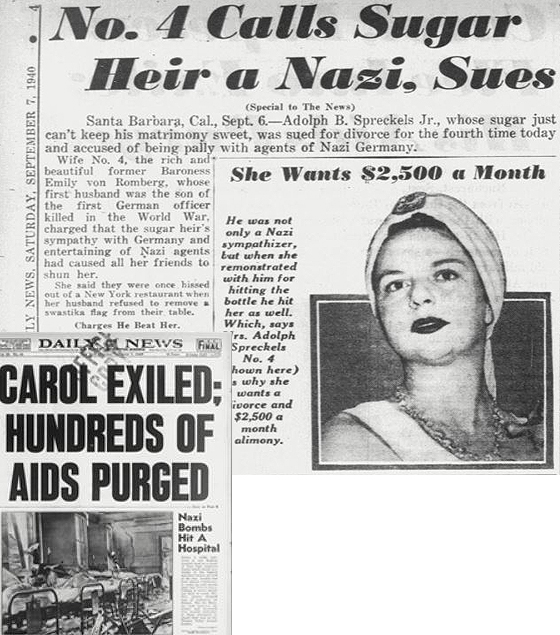
Above, news clipping in New York Daily News on 7 September 1940, with re-used photo of Emily wearing diamonds estimated in value today of USD$14-220 million at the Beaux Arts Ball in New York. Bottom left, front page of newspaper reporting on chaos in Romania and a Nazi bomb hitting a hospital in London. Here, Emily is about the age of 32.
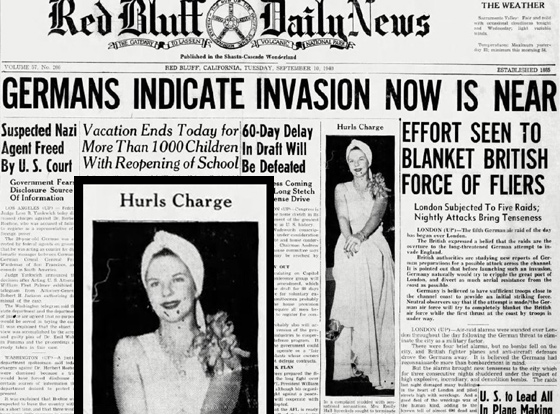
Above, sample media coverage in a smaller media market across America, here on the front page (cropped) in Red Bluff, California on 10 September 1940, with another re-used photo of Emily wearing the diamonds just earlier in the year. The photo caption says, "In a complaint studded with sensational allegations..." (presumed wire service unspecified.)
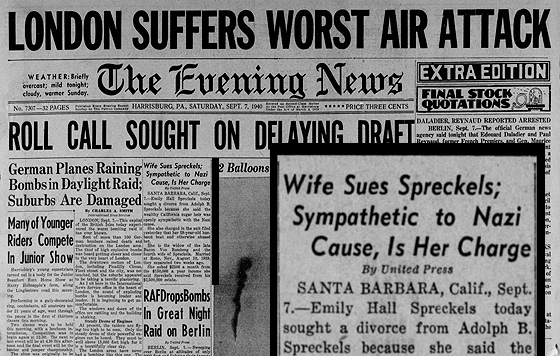
Here, a sample of a mid- to small city newspaper running the story, in Harrisburg, Pennsylvania, the state’s capital, on the front page, third column at top, with no wire service photo. Headline: Wife sues Spreckels; Sympathetic to Nazi cause, is her charge (United Press wire).
A historical MeToo victim, speaking out publicly via a divorce filing, the press at times either downplayed or ignored the extreme violence. [His later girlfriend alleged that he tried to set her on fire, and his later wife, actress Kay Williams (who later married Clark Gable) allegedly received a brain concussion. Spreckels was then sent to jail for "wife beating". Both stories were also covered extensively throughout the United States via wire service reports across waves of the developing stories. Spreckels’ later history was not put forth in earlier histories of Emily, presumably not known.]
Three months later into the divorce case, Spreckels made counter-pro-Nazi allegations against Emily and her deceased first husband Max. In the nationwide press, the divorce attempt and allegations were, at times, considered a bit of a joke, excesses of the rich, via tabloid newspaper coverage. The nationwide reporting cycles were frequent, from September 1940 to April 1941, covering developments in the case.
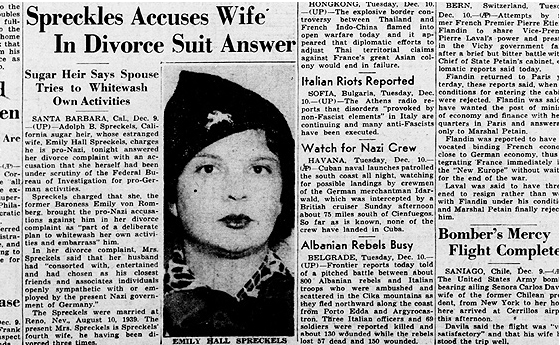
Cropped view, bottom front page, Pittsburgh Post-Gazette, 10 December 1940, United Press wire (among others) reporting on the divorce case. Front page headline: "British Blitzkrieg Begun in Egypt; Greeks Drive For Another Seaport". Re-used photograph, cropped, from July 1933 of society mention— Emily and her deceased husband arriving by ship into the port of Los Angeles. (He’s cropped out.) Note the mention that she was accused of being under the scrutiny of the FBI. My recent FBI FOIA requests regarding Emily— and Max— both came up empty. In time, we will find out if she was maybe interviewed regarding someone else or others.
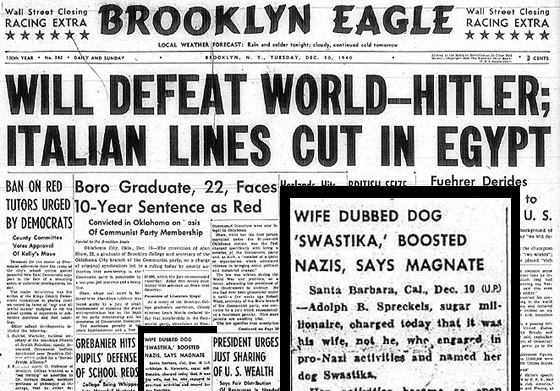
Sample media coverage, front page, Brooklyn Eagle, 10 December 1940; third column, "Wife dubbed dog...", another United Press wire.
Mystery and— significant trauma?
Emily’s surviving 1930s scrapbooks include mainly a combination of personal photographs and selected media coverage— with some bits appearing pulled out by Emily, presumably, later. This wildly contrasts with the extensive, full-on media coverage on her in the 1930s that can be seen in "hidden" newspaper databases visible through libraries, among waves of more and more digitization and easier search capabilities. The difference in "presentation" suggests that Emily may have experienced significant trauma.
The differences are just too glaring. For example, the media coverage lead up to her first husband’s death in a plane crash is largely missing; instead, there are letters right up to the crash between Max and Emily and a seemingly unrelated article a couple of years earlier highlighting fast living seems to preview his death. There’s also a photograph of her in 1937 with Max and two friends (Philip Chancellor, socialite, adventurer, photographer, later in U. S. military intelligence and his wife Elza Chancellor, former Berlin silent film star, Hungarian, possibly Jewish, who fled and married Philip in London, around when Hitler took power in 1933. Then Elza got her mother out, then her cousin. Her father was a deceased merchant in Berlin. This is all shown in unearthed travel and immigration documentation.) This photo (below) of the two couples together, for me, holds very deep mystery, and I am learning, very deep knowledge, as if the key to understanding Emily’s context of danger at that time in full. When one learns what is happening in their four lives at that time and into the near future, this photo is wildly intense, and it makes me wonder why Emily kept it. This is one of many photos of Elza and Philip with Emily and Max, some are newspaper clippings, in Emily’s scrapbook.
Further, apart from a mysterious, cropped view of the mansion in San Francisco of her mother-in-law, arts patron Alma Spreckels (the mansion now owned by novelist Danielle Steele), and a few cards and brief notes from Adolph, the entire Spreckels experience is missing.
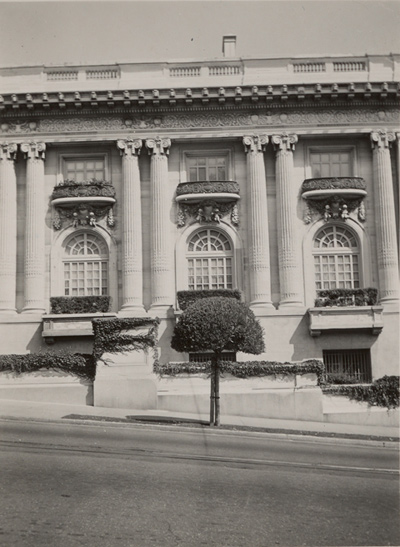
Photo, cropped, of Spreckels mansion in San Francisco in Emily’s papers. Assumptions and interpretation: Emily chose to keep this photo and it means something to her. (Her kept photos don’t really showcase status architecture, based on the number of sites she visited in her life). This may have a personal meaning. Its cropped nature, assume chosen and in relation to Emily’s great eye, focuses on a specific view, not the entrance, perhaps representing a person. It might be philanthropist and art collector Alma Spreckels; in 1948, Emily put up her travelling Miller Company Painting toward architecture 28+-venue exhibition at the Palace Legion of Honor, a site funded by Alma Spreckels and her husband, completed in 1924. So, presumably, no hard feelings. Speculation: with photo kept, a distant warm memory, and it may have something to do with help received in relation to the battle with her son, Adoph B. Spreckels, Jr., and / or a certain admiration.
Also striking is that a news clipping photo like above of Emily wearing the diamonds, published in any of a range of newspapers, is not in her scrapbook. There’s no mention of it. While a significant media moment, this absence was the case, after all of that effort to arrange the diamonds—presumably rented, the security around her, the photo shoot with different poses, which beat out the publicity competition at the high-end party— both flashy and partly a piss-take, and won that media "prize". Perhaps the associations to it, and the later re-usage of the photo against her, destroyed any sense of accomplishment.
Instead in Emily’s scrapbooks, certain key people, a very limited few, whom she wanted to remember, and a much smaller selection of media coverage describing events, remain. Many of these people in the scrapbooks strongly suggest that Emily was indeed anti-Nazi, in some kind of battle, when one takes the time to learn who they were.
In fact, Emily herself is right next to five people in the Pulitzer Prize history finalist Hitler in Los Angeles: How Jews foiled Nazi plots against Hollywood and America (2017), drawn from a little-known, Jewish and sympathizers-led spy files archive in the Los Angeles area. But Emily is not mentioned in this book. In time, we will find out more about Emily’s life and those around her.
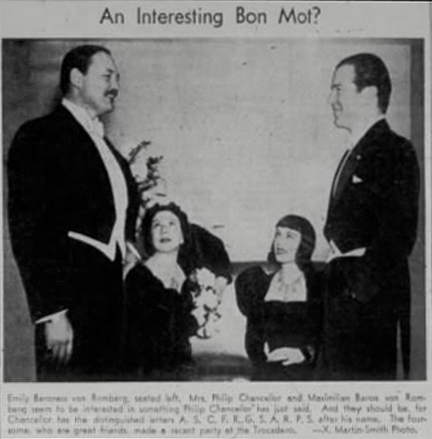
At the Trocadero, photo (L to R): Philip Chancellor, Emily von Romberg, Elza Chancellor, Max von Romberg in the Daily News (Los Angeles) in September 1937. To come: (a) a month later, an alleged British Nazi, an actor’s brother, is reported to have attempted to extort money from Philip, which results in a well-reported trial. A "Baroness von ---" (likely Emily,and therefore likely a witness for the prosecution, but not yet confirmed) is mentioned in a funny aside in a wire regarding the trial; the alleged extortionist got caught on tape saying that the baroness was trying to lure him into the bedroom, to which he denied. In Hilter in Los Angeles, we learn that the alleged Nazi, with the money from Philip, was planning to use it to fund the assassination of 24 prominent and famous Jewish studio heads and actors, in the chapter "Slaughter the Hollywood Jews". The actor’s brother was allowed to leave immediately by ship to England, and the alleged planned massacre did not take place.
(b) The following year, Max’s plane nosedives into a river, while he is quietly applying for US citizenship and expatriating from Germany. Specifics are not yet known, but there is mention of pro-Nazis working in aircraft maintenance at the airport that Max flew out of, and the state aviation report presumably did not survive, and its context is curious particularly with regard to previous eyewitness accounts. Also, at this juncture, it is not known specifically what impact threatening German government directives concerning German passport holders in California had on Max and Emily, if any. (See more about Emily and Max von Romberg.)
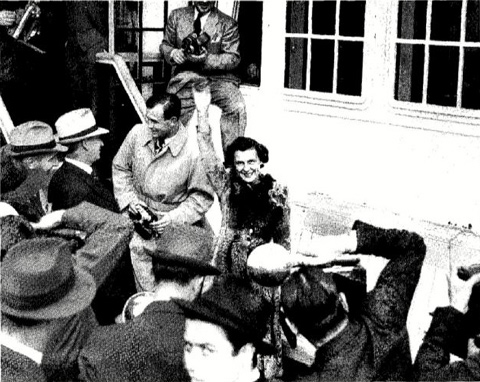
Leni Riefenstahl arriving in New York, 4 November 1938, greeted by the press.
(c) In 1938/1939, Emily meets Leni Riefenstahl, she says for an hour, in her deposition. She says that she only knows of her as an actress and filmmaker. This is towards the end of Riefenstahl’s disastrous publicity junket across America right after Kristallnacht. The only link between Emily and Leni found so far is Elza, the former Berlin silent film star. Perhaps coincidentally, her former screenplay writer, also Hungarian, and Jewish, Béla Balázs, was the writer for Leni’s 1932 film, Blue light. There may be other connections. It is unclear what the purpose of the visit was— empathetic, approval, or information-gathering. It is not known if Elza or others were with Emily meeting Leni. Apparently Leni’s archive does not include any correspondence prior to 1945.
(d) In April 1940, Emily hosted an event in her house in Montecito / Santa Barbara for Queen Victoria’s grandson, the Duke of Saxe Coburg and Gotha, and ally to Hitler. (Search his name on YouTube to see a documentary of what people found out presumably later of what he was associated with. It is as shocking as it gets.) This was the main allegation against Emily and was reported in the area news. This event took place after the Duke, travelling as Head of the German Red Cross, visited with President Roosevelt. There also was a luncheon with most of "the fashionable world" at the Beverly Hills Hotel. In deposition, Emily says that she did it as a favor for Elza, presumably a favor by Elza in relation to the Duke, or Gyssling, or someone else, for reasons not yet known. (There could be many varied reasons, among a method to get someone out of Germany, prison, etc. given Elza’s earlier experience.) Emily says, first she was told that the Duke was "Queen Victoria’s grandson", and then later she learned he was head of the German Red Cross, and then later his Nazi regime connection, and by that time it was too late to cancel. The event pulled in a certain strand of Santa Barbara’s elite. The list of reported attendees is... not yet known.
A month earlier, Emily met German Consul to LA, Georg Gyssling, at Elza’s house. As recent as 2017, a key find in Hitler in LA, it just became known that Gyssling was a kind of double agent, cleared at Nuremburg, partly with testimonial by his friend, top Jewish military intelligence guy, Julius Klein. Gyssling was passing on intelligence. Gyssling also supplied the guest list for the Duke’s event at Emily’s house. Afterwards, Elza and Emily appear to have remained friends, and Emily kept several photos of Elza in her scrapbook; not one photo of Adolph B. Spreckels, Jr. was kept.
Further research regarding these matters is in progress. Philip is noted as later working in military intelligence during the War. The husband of Emily’s sister, Jane Noble, whom Max in 1937 willed his estate to if Emily had passed away, was Assistant to the Assistant Secretary of the Navy. (In January 2023, it was learned that Emily’s sister’s husband, J. Bennett Noble, worked in US naval intelligence, and for a time, second-in-command to the head of this area for Southern California, Ellis M. Zacharias. This was the main government recipient of SoCal Nazi intelligence and sent to Hoover in Washington, DC. Further, social news reports were found showing Ellis and his wife socializing with Emily, her sister, her brother-in-law, her mother, and her best friend after the divorce case in 1940-41 and after the attack on Pearl Harbor.)
Jane and her husband were the parents of Emily’s niece, Janie, noted above. Janie passed away about 5-6 years ago; I was told that she kept calling the magazine to run a feature on her aunt Emily. I was also told that Janie said that she knew nothing about her aunt and the pro-Nazi allegations. During the late 1930s, Janie’s father asked Emily if she would be the child’s godmother; Emily kept that letter. However, no direct links from Philip, Max, Elza, or Emily, or Emily’s brother-in-law to Julius Klein in U. S. military intelligence have yet been identified. Although in 1935, Rupert Hughes was huddled with Klein against LA Nazis, and Emily was huddled with Hughes at roughly the same time.
In c. 1942, it is reported that Philip and Elza, and Emily’s sister Jane and her husband, are dining together at... the Hotel del Coronado... next to the naval base. It was also reported afterwards that Emily was a guest in the hotel. It is understood that the Spreckels trust owned the hotel until 1948.
Somehow moving forward
After the divorce attempt was dismissed in 1941, Emily found a way to get past all of this. She was no longer in the national press and society mentions unlike before. (Newspaper photos of Emily from the 1930s regarding society matters were re-used "against" her. There are a range of possible reasons for her comparative disappearance in national media, with the Pearl Harbor attack in December 1941. Meanwhile in the Santa Barbara News-Press, the social media coverage continued.)
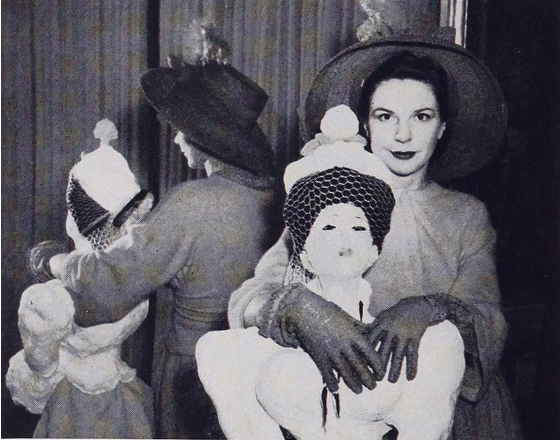
Published in March 1941, during the divorce attempt, Emily in Town & Country, presumably the next-to-last photo placement in a decade-run of fashion / society photo-oriented placements in her diversified national media coverage. When the photo was taken is unknown, but may have been months earlier. Her last photo placement was with Adolph B., a "reconciliation" photo with the two attending a David Selznick play in Santa Barbara. Emily finally was able to divorce Adolph at the end of WWII, her third attempt. When she filed after her first attempt, she said they never did reconcile. Emily is about the age of 33 here.
By 1944, Emily moved East, married Burton Tremaine a year later, and directed her energy to promoting her developing art organizing and contemporary artworks that she acquired with a dynamic communications sensibility. She moved the camera lens away from herself to the artworks. With Emily’s 28+-venue Painting toward architecture, 1947-52, a post-Bauhaus art / architecture / design crossover project, she also chose a man from a prominent Jewish family, Serge Chermayeff, and two men later known to be gay to publicly front her project at events and in the press, and in essence, a carryover of her 1934-36 Aperitif magazine agenda. Emily also became known for her great eye for emerging (anti-Nazi) contemporary art. With her sensibility, this resulted in artworks in her collection being lent to hundreds of international exhibitions and mentioned and illustrated in hundreds of publications.
Robert Preece is author of the forthcoming book Nazis in California: Danger, madness and decadence in high society, 1933-45 (2025).
It is also important to note that the extensive media coverage of this era is not really searchable on the Web. One must dive into a range of newspaper databases, often available in strong libraries with depth of coverage, and still more publications are being digitized which will show more in a more easily searchable manner.
For more information, see Section I. Mystery, danger & misunderstandings: Emily Hall Tremaine in the 1930s on the Emily Hall Tremaine / Tremaine Collection compilations and documentation overview page.